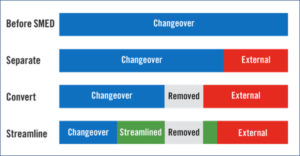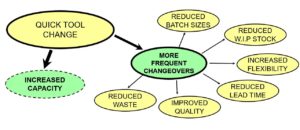Igniting Transformation with Lean Philosophy
Lean Manufacturing, a philosophy embedding a culture of efficiency and continuous improvement, has revolutionised industries worldwide. Its inception within the automotive industry to today’s widespread application showcases its universal benefit across various sectors. When considering Lean Thinking, one can’t help but admire its holistic approach to streamlining operations, enhancing product quality, and boosting customer satisfaction.
Throughout my career, from my initial days as an engineer at a small SME to my role as a corporate executive, I have witnessed firsthand Lean Manufacturing’s transformative potential. My journey into the world of Lean began with a simple yet profound introduction to the concept of Kaizen while working at Linread Northbridge, a precision fasteners manufacturer for the aerospace sector. This pivotal moment sparked a lasting passion for Lean principles that I’ve carried through to every organisation I’ve served (including my own businesses, New Way Growth, FactoryIQ and obviously TCMUK Limited), assisting Manufacturing SMEs in realising their full potential through strategic Lean interventions and comprehensive programs.
The First Step to Lean Success: A Kaizen Event
Reflecting on my first engagement with Lean, a SMED event aimed at reducing a Header Machine’s changeover time from an entire shift to a mere 30 minutes stands out. This experience, under the guidance of a seasoned Japanese Sensei, was not merely about time reduction. It was a lesson in unlocking hidden potential, leveraging precise KPIs, and fostering a mindset geared towards continuous improvement. From relocating machining centers to implementing strategies that yielded savings of over £15 million in the first year, the principles of Lean Thinking have proven time and again that with the right mindset, ‘impossible’ is merely an opinion.
Overcoming the “It Won’t Work Here” Mentality
Resistance to change is a common theme in any organisational transformation. Yet, the principle of marginal gains teaches us the power of incremental improvements. By nurturing a culture that embraces every opportunity for growth, however small, organisations can witness significant advancements over time. The essence of Lean is not in the complexity of tools or techniques but in harnessing the collective knowledge and creativity of its people to drive enduring improvement.
More Than Techniques: A Cultural Shift
Lean Manufacturing transcends mere operational tactics; it represents a fundamental shift in organisational culture and mindset. Its success is contingent not on the size of the company but on the depth of commitment to these principles by its leaders and teams. Engaging closely with the ground-level processes, understanding the real challenges, and courageously tackling the root causes, paves the way for sustainable growth and competitive advantage.
Conclusion: Lean Leadership and Organisational Excellence
The journey towards Lean excellence is ongoing and evolving. It demands a leadership style that is hands-on, empathetic, and visionary. As organisations venture into this transformative path, they unlock efficiencies, eliminate waste, and set new benchmarks of performance. The legacy of Lean is not just in its methods but in the cultural rejuvenation it brings about, fostering an environment where continuous improvement becomes the norm, not the exception.
Lean Manufacturing is more than a methodology; it’s a catalyst for redefining excellence in the manufacturing sector. So, as you delve into the world of Lean, remember, the journey is as rewarding as the destination. Embrace each challenge, celebrate every small win, and continuously strive for a better, leaner, and more efficient tomorrow.
For personalised advice, practical insights, and to explore how Lean can revitalise your manufacturing processes, please feel free to reach out.











